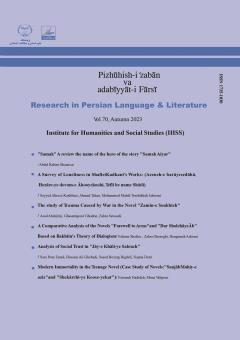In this essay, "Where is Khezr?" composed by Dr. Taqi Pournamdarian, is analyzed based on an intertextual approach. The purpose of this research is to illuminate the relation of pictures in this poem with classic poem, showing the relation of components of mystical, epi
More
In this essay, "Where is Khezr?" composed by Dr. Taqi Pournamdarian, is analyzed based on an intertextual approach. The purpose of this research is to illuminate the relation of pictures in this poem with classic poem, showing the relation of components of mystical, epic, lyric genres and the type of their combination in the creation of contemporary romantic poem. The word "Khezr" has mystical and epic implications. According to the feature of Khezr who is the helper of the lost, it is expected that the narrator of "Where is Khezr?" be confused and wandering in spiritual journey abstinence domains. Such implications can be observed in words and terms like "darkness", "alkahest" (i.e. water of life), "the desert of night". On the other hand, based on the content of poem, there would rise this question that how are elements of poem and its different semantic implications interrelated to each other?
The results of the current research shows that this poem is lyric and it describes an earthly beloved, but there are symbols of other genres. The narrator of the poet passes difficult stages like an epic hero to reach their target, for example s/he passes darkness land. Fourfold sections of the poem associates four seasons. These seasons are periodical like epic time and do not have linear circuit. Separation and tinker would occur simultaneously with passing of different seasons. This poem is the product of conflux and different genre association which is emerged from the unconscious of the poet who had lived in the ecology of cultural worlds. In this article the intertextual analysis of poem was applied and components of different genres were compared and analyzed and their ratio in producing a coherent and structured text was also reviewed.
Manuscript profile


